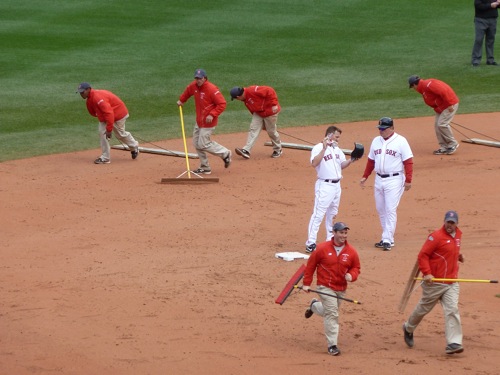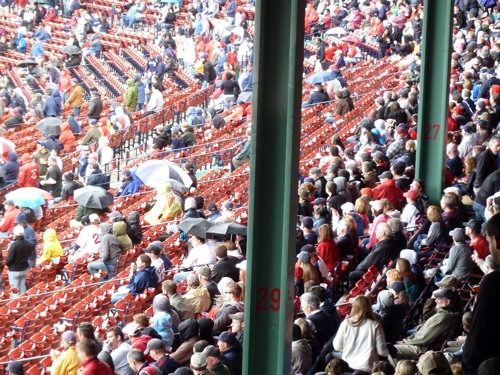While I’ve been training for the 1000-meter flatwater sprint all week, sadly, all of my workouts have been on land. The rental facility that I use stops issuing kayaks after 6pm this time of year. My work schedule keeps me from Cambridge into the mid-evening and therefore quite dry. I’ve been scheming ways to get onto the water in the early morning or later after I get back home, but until then, I’m bound to the gym. The weekends are another story, however. And to ready myself for tomorrow’s lesson, I returned to the river to practice on my own.
There was a bustle at Paddle Boston when I arrived around 11:30 am. A line emanated from the tent which guards the entrance to the dock where newcomers must sign waiver forms and hand over IDs. Another line wrapped around the small cabin that houses the cash register for paddlers who had just returned. No one looked too wet. And as a matter of course, a third line filled the docks which are already crowded by life jackets, paddles, and boats. Despite all of the people there, very few of them were workers. School is about to start and many of the staff are college students on summer vacation. With September just a few days away, most of the attendants have quit, leaving one exasperated woman to man the boats with only occasional help from her tiny dog.
Initially she told me to hop into a recreational kayak. I felt bad asking for a sea kayak instead; I didn’t want to be trouble. She let out something between a sigh and huff and disappeared for a moment. When she returned, I had a sky blue sea kayak. The fin on the bottom was exposed. She reached for the cord to retract it and mentioned to me, “This is how you pull in the.”
“Skeg,” I interrupted to let her know that I was an insider, too.
“Yeah,” she replied. Her pace was a little slower and tone a little warmer than before. “Well, get in. I’ll push you in water from here since there’s such a line.” Trying not to sour my new friendship, I did as she said silently and swiftly. I signalled my readiness with a brief nod.
“Well, aren’t you going to adjust your foot pegs?” she asked. To be honest, I didn’t remember how far down the pegs were supposed to be. During my lesson the week before the instructor had adjusted them for me. My feet were on them. And that seemed right. So, I replied quickly, “They feel good.” What a mistake.
Once I was in the canal, the winds seemed to kick me side to side. The boat tottered beneath me in reponse. My abs clenched. For a moment, I forgot to breathe. And then I began what I could remember of the forward stroke. Toe-to-hip. Turn to the other side. Toe-to-hip. Turn and repeat. Somehow I was more unsure of myself than I was my first time out. The water was less familiar and I was more afraid of falling in. Still, I inched out of the canal.
Now in the open Charles, I suddenly realized that my right foot was up further than my left. And I remembered how I was supposed to sit in the kayak: somewhat frog-legged, with knees pushing on the braces on either side of the hull under the coaming. Damn. My foot pegs were too far down and uneven, and I could already feel my hips straining. I headed upstream under the Longfellow Bridge toward the only landing I could remember, up near the Harvard River Houses and Week’s footbridge, where I could stop to rearrange the pegs.
The entire time, my boat kept lurching to the right. I thought it might be the wind pushing me to one side. The week before, the entire class kept floating to toward the shore as a pack. I put my paddle down to check which direction the currents would take me. To the left! “Ah, so it is me,” I thought. My paddling was so lopsided, it overcame the wind. Every few strokes I paused to right my course. It was those mismatched and misplaced pegs. I picked my knees up higher against the boat. That seemed to help. I looked around at the other craft on the water. Everyone else appeared to be going straight. Then the wind picked up again.
It’s really amazing how low to the water you are in a kayak. Waves that you would never bother to notice from land suddenly command your attention by force. It was hard for me to gauge their size, a few inches, possibly a foot but probably less. But when you’re only three feet above the water, ripples become mountains. After being batted to the side by a small caravan of waves, an old Anglo-Saxon poem the Seafarer popped into my mind. When I discussed it in a waterless meeting room for a college course on Old English poetry years ago, my analysis was sharp. With all the comfort and courage that only cowards could have, I judged the author and his culture as small and afraid. They believed in monsters; I did not. But there, floating alone in my 13-foot boat, all that dross about the grim cold ocean and terrible tossing of the waves and unforgiving gale started to make sense—despite its being a tame New England summer day.
I turned around and headed home, still lurching to the right. This time with help from the wind.
Class is at 8:30 tomorrow morning.

 . The staff had flagged this book as one of their picks, too, and previously caught my eye. So last week I went home with a copy of my very own.
. The staff had flagged this book as one of their picks, too, and previously caught my eye. So last week I went home with a copy of my very own.

